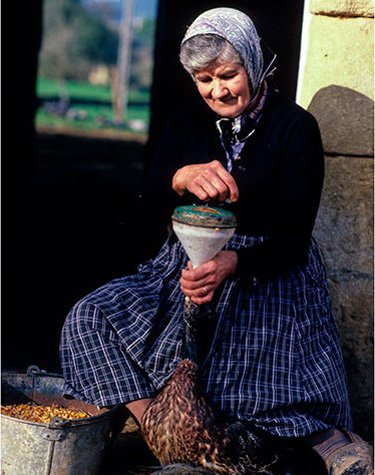Defending Foie Gras
Book Reviews, Cuisine, Foie Gras, History
Paul Levy, in the Spectator, reviews Norman Kolpas’s Foie Gras: A Global History, which defends the rich delicacy and its creation via the practice of gavage (the fattening of geese and ducks by tubular feeding) against a recent wave of Puritanism and snobbish morality posing that got the product banned in California and removed from the shelves of Fortnum & Mason in Britain.
[T]he main opposition claim is that the production of the hyper-fatty livers of ducks and geese is physically cruel and therefore immoral.
The factual argument is just plain wrong, and so is the ethical judgment that depends on it. I have witnessed the ‘force-feeding’ of ducks, and it is not a case of animal abuse. What actually happens is that the nicely behaved ducks (imprinted à la Konrad Lorenz) form an orderly line to take their turn swallowing a flexible tube that in seconds whooshes pellets of maize or mash of cereal down their gullets. They appear to relish this, and are, in my experience, fussed about and petted affectionately by the farming women of the south-west of France who perform what is called the gavage.
The problem, says Norman Kolpas, is that our celebrities and anti-foie gras activists ‘immediately and understandably tend to anthropomorphize the birds, imagining how it might feel for a human to have a feeding tube jammed down the throat’. This image of oral rape comes from an ignorance of bird physiology. The human esophagus is a more rigid structure of muscle, cartilage and bone, and inserting a tube down it means getting past the epiglottis, which triggers the human gag reflex. These waterfowl species do not have a gag reflex.
The gavage, in fact, mimics the birds’ natural pre-migratory behavior; following the seasons, they gorge themselves with food in preparation for their long flights. This had been remarked at least as early as 400 BC, when, says Kolpas, ‘well-fattened geese were deemed sufficiently worthy to be presented as a gift when Agesilaus, king of Sparta, visited Egypt’. The Greeks and Romans force-fed geese with figs rather than grain, a practice later adapted for rich pork liver, as recommended by Apicius. Foie gras found its way to south-western France with the conquest of Gaul (121-51 BC), and then Jewish slaves, cooks and farmers spread it east across Europe. Though goose makes the most appreciated fat liver, the amount of goose foie gras now produced globally has become minuscule (about 5 percent) compared with duck foie gras, mostly from (pond-shunning) hybrid male Moulard ducks, whose meat is also succulent and valued.




